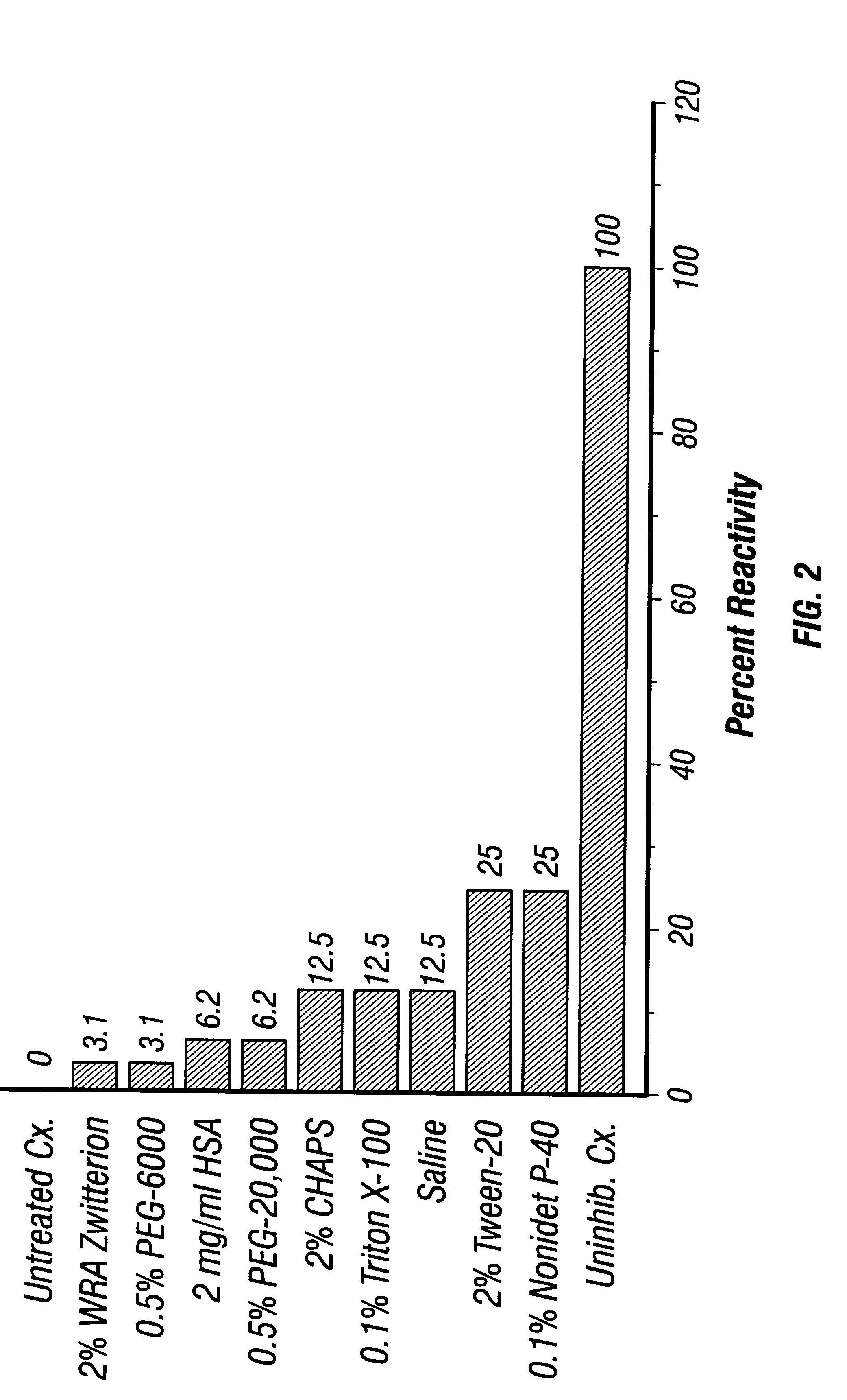RH blood group antigen compositions and methods of use
- Summary
- Abstract
- Description
- Claims
- Application Information
AI Technical Summary
Benefits of technology
Problems solved by technology
Method used
Image
Examples
example 1
5.1 Example 1
Isolation of Active Rh Antigen
5.1.1 Isolation of RBC Soluble Fraction
All operations were carried out at 4.degree. C. unless noted otherwise. Lysis Buffer consisted of 0.01 M Tris-HCl, pH 7.4. Triton Buffer was made by adding Triton X-100 to a final concentration of 10% (wt / wt) in Lysis Buffer. EDTA buffer consisted of 0.1 mM EDTA (pH 8.0). Optionally, the protease inhibitor phenylmethylsulfonyl fluoride (PMSF) was added at a final concentration of 10 .mu.g / ml, although the inventors saw no differences in results using buffer from which PMSF was omitted.
RBC were washed at least 5 times in saline. The packed RBC pellet was suspended in 20 volumes of precooled Lysis Buffer and incubated on ice for 20 min with occasional agitation. The lysate was then centrifuged at 20,000 rpm (48,000.times.g) in a Sorvall centrifuge using an SS-34 (8.times.50 ml) rotor for 15 min at 4.degree. C. Both centrifuge and rotor were precooled to 4.degree. C. The resulting membrane pellets were wa...
example 2
5.2 Example 2
Determination of Activity of Rh Antigen
5.2.1 Enzyme Treatment of Rabbit RBC
Rabbit blood was collected in anticoagulant (Heparin, 20 U / ml), and centrifuged at 2,000 rpm (900.times.g) for 15 min at 4.degree. C. The RBC pellet was resuspended and washed at least 3 times in normal saline (0.85% NaCl). In a tube containing 2.4 ml of PBS and 280 .mu.l of a 1:3 dilution of Bacto Trypsin (Difco) (equivalent to 200 1g / ml trypsin) and 100 .mu.l packed, washed RBC were added. This mixture was incubated for 10-15 min at 37.degree. C., then centrifuged and washed at least 3 times in normal saline. The pellet was then resuspended in a total volume of 5 ml to make a 2% suspension.
5.2.2 Ficin Treatment of Human RBC
Human Rh.sup.+ blood was collected from a blood bank unit in anticoagulant (citrate-phosphate-dextrose) then centrifuged and washed in PBS. One ml of packed RBC was mixed with 1 ml of PBS in a test tube. In a second tube, 2.25 ml PBS and 37.5 mg of Ficin (Sigma Chemical Co., ...
example 3
5.3 Example 3
Methods for Preparing Immobilized Rh Antigen
5.3.1 Coating Beads
Glass or plastic beads (50 .mu.m diameter) were washed in EDTA buffer, pH 2.4 and the supernatant was discarded. One ml of bead pellet was mixed with 2 ml Rh antigen of 1.3 OD.sub.280 units (1 cm path length) which was made 0.2 M in glycine by adding dry glycine and the pH was lowered to 2.4 using 6 M HCl, and the mixture is agitated for 16-48 hr at 4.degree. C. The mixture was centrifuged and washed 3 times, the total volume and final OD.sub.280 of each supernatant was collected and measured. The total protein recovered in the washes was determined and compared with the total amount of Rh antigen added for determination of adsorption percentage.
5.3.2 Coating ELISA Wells
ELISA wells are coated with 50-75 .mu.l of Rh antigen which was made 0.2 M with respect to glycine and the pH was lowered to 2.4 using 6 M HCl. Plates were incubated for various times (4-16 hr) at various temperatures (room temperature or 4.d...
PUM
| Property | Measurement | Unit |
|---|---|---|
| Fraction | aaaaa | aaaaa |
| Fraction | aaaaa | aaaaa |
| Fraction | aaaaa | aaaaa |
Abstract
Description
Claims
Application Information
 Login to View More
Login to View More - R&D
- Intellectual Property
- Life Sciences
- Materials
- Tech Scout
- Unparalleled Data Quality
- Higher Quality Content
- 60% Fewer Hallucinations
Browse by: Latest US Patents, China's latest patents, Technical Efficacy Thesaurus, Application Domain, Technology Topic, Popular Technical Reports.
© 2025 PatSnap. All rights reserved.Legal|Privacy policy|Modern Slavery Act Transparency Statement|Sitemap|About US| Contact US: help@patsnap.com



